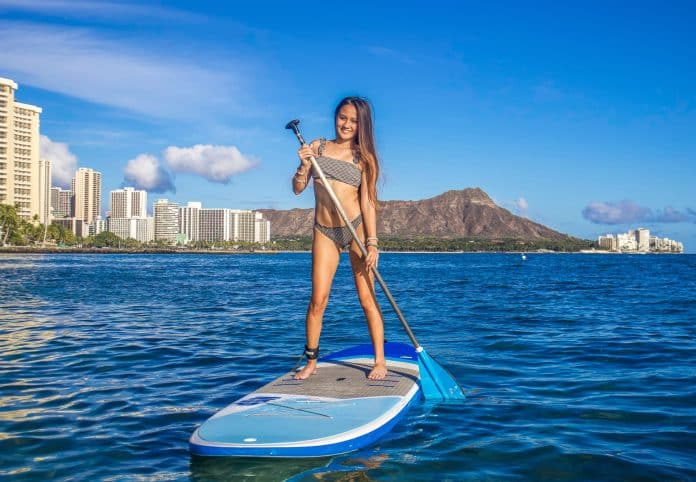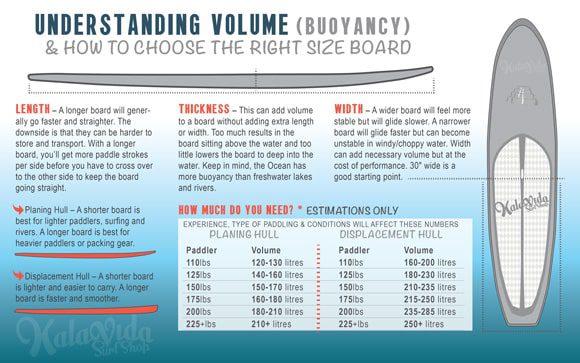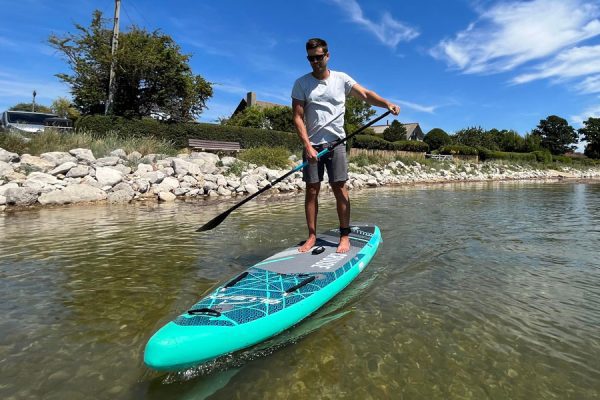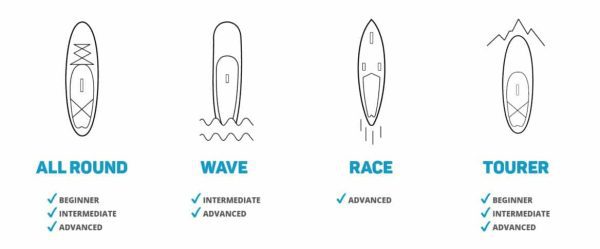Are you a beginner looking to get into stand-up paddleboarding (SUP)? We understand that choosing the right board can be overwhelming with so many options available.
That’s why we’re here to help! This article will guide you through selecting a beginner SUP board, considering stability, durability, and size.
By the end, you’ll feel confident in making an informed decision and ready to embark on your exciting SUP adventure. Let’s dive in and explore the world of beginner SUP boards together!
Consider your skill level.
Assess your experience with paddleboarding.
When choosing a beginner SUP board, it’s essential to consider your experience with paddleboarding. If you’re a complete beginner, you’ll want to look for a board designed for beginners that offers stability and ease of use. On the other hand, if you have some experience with paddleboarding, you may be ready to try a board that offers more maneuverability and performance.
Take into account your level of fitness.
Your fitness level should also be considered when choosing a beginner SUP board. If you’re a beginner with a lower fitness level, you may want to look for a board that offers more stability and is easier to paddle. On the other hand, if you’re more physically fit and have a good balance, you may be able to handle a board that offers more speed and maneuverability.
Consider your comfort on the water.
Comfort on the water is another essential factor when choosing a beginner SUP board. If you’re uncomfortable being on the water, you may want to look for a board that offers stability and is easy to control. On the other hand, if you’re comfortable on the water and want to explore different types of paddleboarding, you may want to choose a board that offers more versatility and performance.
Determine the type of paddleboarding.
Decide between water and surfing.
The first decision you’ll need to make when choosing a beginner SUP board is the type of paddleboarding you want to do. Flatwater paddleboarding is excellent for calm lakes, rivers, and bays, while surfing paddleboarding is more suitable for ocean waves. Consider your location and the water conditions you’ll be paddling in to determine which type of paddleboarding suits you best.
Consider your local water conditions.
Before choosing a beginner SUP board, it’s essential to consider your local water conditions. If you’ll be paddleboarding on calm lakes or rivers, a board with good stability and tracking will be ideal. However, if you navigate ocean waves, you’ll need a board that offers more maneuverability and agility.
Evaluate your intended use of the board.
Another factor to consider when determining the type of paddleboarding is your intended use of the board. Do you want to use it for leisurely paddles? Are you interested in SUP yoga or fishing? Or do you see yourself progressing to more advanced paddleboarding activities? Consider how you plan to use the board to ensure it meets your specific needs and preferences.
Choose the right board size.
Consider your weight and height.
When choosing the right board size, your weight and height play a crucial role. A board that is too small for your body weight may sink and become unstable, while a board that is too long or wide may be challenging to maneuver. Finding a board that provides enough buoyancy and stability based on weight and height is essential.
Look for recommended weight and size ranges.
Most SUP boards come with recommended weight and size ranges. These guidelines help determine the appropriate board size for your body type. Pay attention to these recommendations and choose a board that falls within the range specified for your weight and height.
Take into account your stability needs.
The board size you choose will also depend on your stability needs. If you’re a beginner or value stability, consider opting for a broader and longer board. These dimensions will provide a more stable platform, making it easier to maintain balance and gain confidence in the water. However, a narrower and shorter board may be more suitable if you prioritize speed and maneuverability.
Decide on the board shape.
Understand the differences between planing hull and displacement hull.
When choosing a beginner SUP board, it’s essential to understand the differences between a planning hull and a displacement hull. A planing hull is broader and flatter, making it more stable but slower in the water. A displacement hull, on the other hand, is designed to cut through the water more efficiently, offering better speed and tracking. Consider your primary paddling environment and intended use to determine which hull shape suits you best.
Consider your primary paddling environment.
Your primary paddling environment should also influence your decision on board shape. If you’ll be paddleboarding in calm water, a planning hull may be more suitable as it provides better stability. However, a displacement hull is recommended for its superior tracking and performance if you navigate choppy waters or waves.
Evaluate the maneuverability and tracking of different shapes.
Maneuverability and tracking are vital considerations when deciding on the board shape. A broader, shorter board will offer better maneuverability, making turning and navigating tight spaces easier. Conversely, a longer and narrower board will track straighter, which is advantageous for longer distances or more advanced paddleboarding maneuvers. Consider your skill level and intended use to find the right balance between maneuverability and tracking.
Evaluate the board construction.
Differentiate between epoxy, soft-top, and inflatable boards.
When choosing a beginner SUP board, it’s essential to understand the different board construction options available. Epoxy boards are typically made of fiberglass and offer a good balance of performance and durability. Soft-top boards have a foam deck for added comfort and are often more forgiving for beginners. Inflatable boards are made of strong PVC material and are the most portable and convenient option.
Consider the durability and maintenance requirements.
Durability and maintenance requirements are essential factors to consider when evaluating board construction. Epoxy boards are generally more durable but may require more regular maintenance and care. Soft-top boards are more resistant to dings and scratches, making them a durable option for beginners. Inflatable boards are highly durable and require minimal maintenance, making them an excellent choice for those who prioritize convenience.
Assess the weight and portability of the board.
Weight and portability should also be considered when evaluating board construction. Epoxy boards can be heavy to transport, requiring specialized racks or trailers. Soft-top boards are typically lighter and easier to handle. Inflatable boards are the most lightweight and portable option, as they can be deflated and packed into a backpack for easy transportation. Consider how you plan to transport and store your board to determine the most suitable construction type.
Check the board’s stability.
Look for stability features like width and thickness.
Board stability is crucial, especially for beginners. When choosing a beginner SUP board, look for stability features like width and thickness. A broader and thicker board will provide more stability, making it easier for beginners to find balance and feel confident on the water. However, striking a balance is essential, as excessively wide or thick boards may sacrifice maneuverability.
Consider the rocker profile and its effect on stability.
The rocker profile, or the curve from nose to tail, influences board stability. A board with more rocker will be more maneuverable and suitable for surfing or navigating waves. However, it may sacrifice stability on flat water. Conversely, a less rocker board will track straighter and provide better stability on calm water. Consider your primary paddling environment and intended use to find the right rocker profile for your stability needs.
Evaluate the volume and buoyancy of the board.
Volume and buoyancy are additional factors to consider when checking board stability. Higher volume and buoyancy boards will provide excellent stability and weight capacity. If you’re a beginner or plan to bring additional gear or equipment, opting for a board with higher volume and buoyancy will ensure better stability and performance. However, higher volume may make the board less agile and responsive.
Consider the board’s maneuverability.
Assess the board’s length and width.
When it comes to maneuverability, board length and width are important considerations. A shorter and wider board will be more maneuverable, making turning and navigating tight spaces easier. This is advantageous for beginners or those who prioritize maneuverability over speed. On the other hand, a longer and narrower board will track straighter and provide better speed, which is beneficial for more advanced paddleboarding or longer-distance paddles.
Consider the fin setup and its impact on maneuverability.
The fin setup of a SUP board also affects maneuverability. Multiple fins, known as a thruster setup, provide better maneuverability, allowing for sharper and quicker turns. However, this setup may sacrifice straight-line tracking. A single fin setup offers better tracking and stability, making it suitable for flatwater or distance paddling. Consider your intended use and paddling style to determine the proper fin setup for your maneuverability needs.
Evaluate the board’s rocker and its effect on turning.
The board’s rocker also affects maneuverability, especially when turning. A board with more rocker will have a shorter waterline, allowing for quicker and more responsive turns. This is beneficial for surfing or navigating through waves. However, a less-rocker board will track straighter and provide better speed. Consider your primary paddling environment and intended use to find the right rocker profile for your maneuverability preferences.
Take into account the board’s weight capacity
Check the manufacturer’s weight capacity recommendations
Weight capacity is an important consideration when choosing a beginner SUP board. Check the manufacturer’s weight capacity recommendations for the board you’re considering. Choosing a board that can comfortably support your weight is essential, as exceeding the weight limit may compromise the board’s stability and performance.
Consider the weight of any gear or equipment you plan to bring
In addition to your body weight, consider the weight of any gear or equipment you plan to bring on your paddleboarding adventures. This could include a cooler, fishing gear, or SUP yoga accessories. Ensure the board’s weight capacity considers your additional weight to ensure optimal stability and performance.
Evaluate the trade-off between stability and weight capacity.
Balancingtability and weight capacity is critical in choosing a beginner SUP board. While higher weight capacity may offer more versatility and the ability to carry gear, it may also sacrifice stability. Consider your body weight, intended use, and gear requirements to find the right balance that allows for stability while accommodating your weight capacity needs.
Assess the board’s price and quality.
Set a budget for your SUP board.
Setting a budget is an important step when choosing a beginner SUP board. SUP boards come in a range of price points, so it’s essential to determine how much you’re willing to spend. Setting a budget will help narrow your options and ensure you find a board that offers the best value.
Research reputable brands and their product reviews
When choosing a beginner SUP board, it’s important to research reputable brands and their product reviews. This will give you a better understanding of the quality and performance of different boards. Look for brands with positive reviews and a reputation for producing high-quality SUP boards that meet the needs of beginners.
Consider the overall quality and value for money.
In addition to the price, consider the overall quality and value for money when choosing a beginner SUP board. Assess the materials used, construction, and durability of the board. Consider if the features and performance justify the price and if the board will meet your needs as a beginner. Investing in a higher-quality board may provide better long-term value and performance.
Try out or rent different boards.
Visit a local paddleboard rental shop.
If you’re unsure which beginner SUP board to choose, consider visiting a local paddleboard rental shop. This will allow you to try different boards and get a feel for their stability, maneuverability, and overall performance. It’s a great way to gain firsthand experience and determine which board suits you best before purchasing.
Participate in a demo day or try before you buy
Many paddleboard manufacturers and retailers offer demo days or “try before you buy” events. These events allow you to test out different boards and receive expert guidance. Take advantage of these opportunities to paddle various boards and gather feedback to aid decision-making. It’s an excellent way to ensure you choose a board that aligns with your preferences and skill level.
Consider renting before making a final decision.
Another option to consider is renting a beginner SUP board before deciding. Renting allows you to experience different board types and shapes over multiple sessions, giving you a more comprehensive understanding of what works best for you. It’s a cost-effective way to evaluate various options and make an informed decision based on your firsthand experience.
Choosing a beginner SUP board requires carefully considering your skill level, intended use, body characteristics, environmental factors, and personal preferences. By following these tips and researching, you’ll be well-equipped to make an informed decision and embark on an exciting paddleboarding journey.
Remember to prioritize stability, maneuverability, board construction, weight capacity, and value for money to find the perfect SUP board that suits your needs as a beginner. Happy paddling!









































